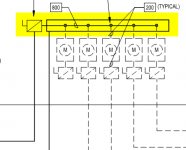Johnhall30
Senior Member
- Location
- -
- Occupation
- -
For a service tapped from a wireway; Using the 25 ft tap rule, can a meter be installed prior to the fused service disconnect protecting the tap conductors?
240.21(B)(4)(4) AND 240.21(B)(4)(6) makes me believe that the overcurrent protection will have to be provided before the meter.
However, it looks like using the 10 ft tap rule, a meter can be installed prior to the disconnect
240.21(B)(4)(4) AND 240.21(B)(4)(6) makes me believe that the overcurrent protection will have to be provided before the meter.
However, it looks like using the 10 ft tap rule, a meter can be installed prior to the disconnect

